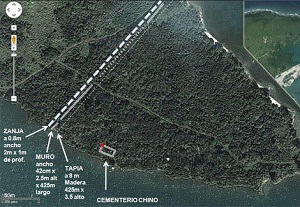 The oldest Chinese cemetery in the Americas – still intact – is found in the Mariel Special Development zone. The necropolis dates back to 1861 and is located on the western periphery of the bay next to Laza cove.
The oldest Chinese cemetery in the Americas – still intact – is found in the Mariel Special Development zone. The necropolis dates back to 1861 and is located on the western periphery of the bay next to Laza cove.
The archeological discovery is relatively recent and was largely the result of specialists’ desire to learn the truth behind an old fisherman’s tale.
However, the economic importance of the port located in the province of Artemisa has made it necessary to preserve this slice of history.
Engineer and provincial vice president of the Cuban Speleology Society, Carlos A. Borrego Quevedo, who also discovered the site – spoke to Granma International about the breakthrough and its patrimonial value.
The remains of how many people are thought to be at this site?
–The latest estimate is 658 according to my most recent investigations which are still underway, and are largely based on referencing documents and newspapers from the time stored in Cuba’s National Archive. So far the remains of 161 individuals have been confirmed.
What makes you believe this cemetery is older than the other famous ones in the country?
There was a Chinese cemetery in Cuba, in Havana, founded in 1893, and therefore it is the oldest on the island. The Wah On Kon Ce Chinese cemetery, located near Chorrillo, Panama, is thought to be the oldest in the Americas, dating back to 1883. Therefore the 1861 site is even older.
I mean it is the oldest preserved necropolis in the Americas, given that there were others in Cuba: that of Regla, which emerged with the arrival of the Chinese immigrants in 1847, but these sites no longer exist due to industrialization or urbanization. They weren’t preserved, thus the important patrimonial value of the one we still have.
What institutions are participating in the investigation?
In June 2012 we decided to carry out investigations on archeological sites in the area to the west of Mariel bay. We leaned of the “leprosy hospital” or quarantine facility and a “Chinese cemetery” from the existing heritage sites listed in a local museum; both of which had still not been discovered, although old fisherman assured us of their existence.
So, we divided up the work: the Mariel historian would investigate the hospital; the experts from the local museum would search through the archives, and I chose to investigate the alleged Chinese cemetery.
After five months of research and searching, I was able to concluded from my investigations (contrary to what I had expected, given that since the beginning there had always been a greater chance that it was only a unfounded legend, rather than a reality) that yes, it was a cemetery, which could be considered to be Chinese given the huge quantity of remains belonging to this demographic and, the most astonishing thing for me was that it is not only the oldest in Cuba, but also throuhout the Americas.
I didn’t discover the Chinese cemetery as old fishermen already knew of its existence. Anyway, I was the re-discoverer. What I managed to uncover was its age.
Since the first article I published in December 2012, announcing the discovery, we contacted the provincial heritage authorities with all work subsequently channeled through this route.
So, in regards to the participation of institutions, we should also mention the Union of Cuban Historians.
What is the patrimonial value of this discovery?
Just imagine its value! The Americas were the destination to which a mass migration of Asians arrived, brought over as an alternative form of labor given the abolition of slavery. Cuba was the first point of arrival in the region.
Even though it’s located on an industrial site, this cemetery is the oldest in the region, and will be preserved for future generations, just like the fragments of the Wall of Havana, on display to visitors in a small park in the capital. It could become a small-scale, targeted tourist attraction, and a source of income for the development zone which would be shown to be working in harmony with surrounding heritage sites – a pleasing feature for foreign investors, especially those from China, who might be considering investing in the zone.
How can the cemetery be preserved in an area undergoing industrial development?
It is in theory already protected as it has been treated as a heritage site from the very beginning.
(Granma)